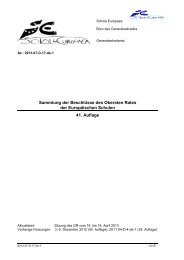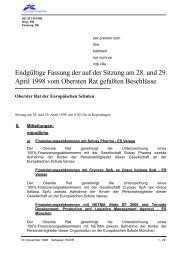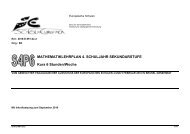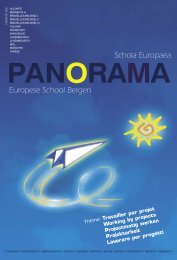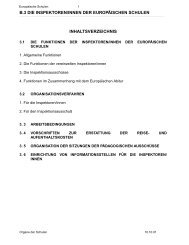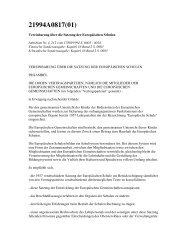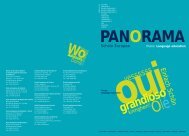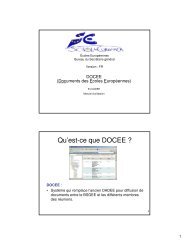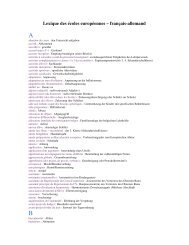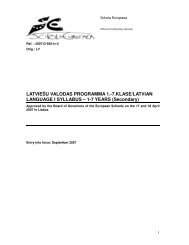External Evaluation of the European Baccalaureate (Annexes)
External Evaluation of the European Baccalaureate (Annexes)
External Evaluation of the European Baccalaureate (Annexes)
You also want an ePaper? Increase the reach of your titles
YUMPU automatically turns print PDFs into web optimized ePapers that Google loves.
that <strong>the</strong> disciplinary knowledge should provide students with skills and understanding needed for life and<br />
work. In <strong>the</strong> case <strong>of</strong> <strong>the</strong> EB <strong>the</strong>re appears to be more emphasis on <strong>the</strong> study <strong>of</strong> ma<strong>the</strong>matics for its own<br />
sake and for higher studies. At <strong>the</strong> risk <strong>of</strong> over-interpretation, this slight difference on <strong>the</strong> importance <strong>of</strong> <strong>the</strong><br />
utility <strong>of</strong> ma<strong>the</strong>matics seems to influence <strong>the</strong> approach to syllabus content and <strong>the</strong> modes <strong>of</strong> assessment.<br />
In <strong>the</strong> case <strong>of</strong> <strong>the</strong> EB <strong>the</strong>re is a greater emphasis on formalism and <strong>the</strong>oretical foundations (see<br />
particularly <strong>the</strong> treatment <strong>of</strong> <strong>the</strong> analysis <strong>of</strong> functions) whereas in <strong>the</strong> Irish system <strong>the</strong>re is a greater<br />
emphasis on intuitive approaches and practical techniques. Never<strong>the</strong>less, both syllabi refer to problem<br />
solving, manipulation (EB) or instrumental understanding (LC), communication and generalising (EB) or<br />
formulating a hypo<strong>the</strong>sis (LC). The Irish syllabus also states as one <strong>of</strong> its aims an awareness <strong>of</strong> <strong>the</strong> history<br />
<strong>of</strong> ma<strong>the</strong>matics. This is not mentioned in <strong>the</strong> <strong>European</strong> <strong>Baccalaureate</strong> syllabus.<br />
The table below is based on a content comparison <strong>of</strong> <strong>the</strong> two syllabi. The sources used were <strong>the</strong> EB<br />
syllabus 2000-D-38 published in 2000 and <strong>the</strong> Irish Leaving Certificate syllabus (1994). The scope <strong>of</strong> <strong>the</strong><br />
EB syllabus is narrower than that <strong>of</strong> <strong>the</strong> LC treating just <strong>the</strong> four areas <strong>of</strong>:<br />
• Analysis,<br />
• Algebra,<br />
• Geometry and<br />
• Probability.<br />
The LC syllabus has seven core areas:<br />
• Algebra,<br />
• Geometry,<br />
• Trigonometry,<br />
• Sequences and Series,<br />
• Functions and Calculus and<br />
• Discrete Ma<strong>the</strong>matics and Statistics.<br />
In addition <strong>the</strong> LC has four optional topics: Fur<strong>the</strong>r Calculus and Series, Fur<strong>the</strong>r Probability and Statistics,<br />
Groups and Fur<strong>the</strong>r Geometry. The structure <strong>of</strong> <strong>the</strong> assessment instrument in <strong>the</strong> EB as well as <strong>the</strong><br />
syllabus aims demand that a student study all <strong>of</strong> <strong>the</strong> topics listed. In <strong>the</strong> case <strong>of</strong> <strong>the</strong> Irish syllabus <strong>the</strong> issue<br />
is somewhat more complicated. As will be discussed later<br />
Comparison <strong>of</strong> syllabus content <strong>of</strong> both syllabi<br />
The content description <strong>of</strong> both syllabi takes <strong>the</strong> form <strong>of</strong> a list <strong>of</strong> topics to be studied in <strong>the</strong> last two years<br />
<strong>of</strong> schooling. The EB specifies particular content for each <strong>of</strong> <strong>the</strong> two years <strong>of</strong> <strong>the</strong> programme (Years 6 and<br />
7 <strong>of</strong> second-level or equivalently Years 12 and 13 <strong>of</strong> formal schooling). The LC does not indicate <strong>the</strong><br />
content specific to each year and in practice it is <strong>the</strong> teacher who decides on <strong>the</strong> division <strong>of</strong> topics studied<br />
in <strong>the</strong> two years. Though in both syllabus documents <strong>the</strong>re is a column to <strong>the</strong> right <strong>of</strong> <strong>the</strong> topic list for<br />
remarks on <strong>the</strong> content, this facility is scarcely used in ei<strong>the</strong>r case. In <strong>the</strong> case <strong>of</strong> <strong>the</strong> Irish syllabus <strong>the</strong><br />
remarks confine <strong>the</strong>mselves to a small number <strong>of</strong> indications <strong>of</strong> exclusions. In <strong>the</strong> case <strong>of</strong> <strong>the</strong> EB <strong>the</strong><br />
remarks are in <strong>the</strong> form mainly <strong>of</strong> elucidation <strong>of</strong> terms used in <strong>the</strong> content column. Nei<strong>the</strong>r syllabus<br />
provides much guidance on <strong>the</strong> depth <strong>of</strong> knowledge that is to be pursued, methods <strong>of</strong> teaching or<br />
presentation, or “real-world” applications that might be considered. In <strong>the</strong> case <strong>of</strong> <strong>the</strong> Irish syllabus support<br />
in <strong>the</strong>se areas is provided by a set <strong>of</strong> Guidelines for Teachers which is not part <strong>of</strong> <strong>the</strong> syllabus<br />
documentation but is available to all teachers through <strong>the</strong> National Council for Curriculum and<br />
Assessment. It has not been possible to establish whe<strong>the</strong>r such support is available to teachers <strong>of</strong> <strong>the</strong> EB.<br />
The difficult but important matter <strong>of</strong> <strong>the</strong> comparative scope or depth <strong>of</strong> treatment <strong>of</strong> content in both syllabi<br />
cannot be addressed using a simple examination <strong>of</strong> <strong>the</strong> written documentation. The only indication in this<br />
regard, based on <strong>the</strong> materials provided and in <strong>the</strong> absence <strong>of</strong> fur<strong>the</strong>r research, is given by <strong>the</strong> written<br />
assessment tools and student responses. This will be commented on in more detail later. With regard to<br />
<strong>the</strong> scope <strong>of</strong> what is actually taught, in <strong>the</strong> Irish Leaving Certificate examination <strong>the</strong>re are no mandatory<br />
questions to be answered by candidates on <strong>the</strong> core topics <strong>of</strong> <strong>the</strong> syllabus and in <strong>the</strong> assessment exercise<br />
in total, 13 questions out <strong>of</strong> 15 are answered on core material. This does indicate that, at least at<br />
assessment, some material may be left out by <strong>the</strong> student although it is usual practice to teach all parts <strong>of</strong><br />
<strong>the</strong> core syllabus. However, only ONE <strong>of</strong> <strong>the</strong> optional topics on <strong>the</strong> Irish LC is usually taught, <strong>the</strong> most<br />
common by far being <strong>the</strong> Fur<strong>the</strong>r Calculus and Statistics option. In <strong>the</strong> written examination <strong>of</strong> <strong>the</strong> EB a<br />
compulsory question must be answered on each <strong>of</strong> <strong>the</strong> core topics. Two fur<strong>the</strong>r questions from three<br />
optional questions on <strong>the</strong> same topics should also be attempted. Both <strong>the</strong> compulsory questions in <strong>the</strong> EB<br />
68



